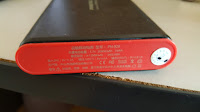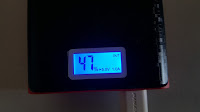PN-920
The light is blue for the LCD screen on the PN-920 and it can be quite irritating and uncomfortable to the eyes due to its brightness. The LCD screen will display some information whenever you perform the following:
- Hold the button for a couple of seconds (Display the remaining percentage with the word "OUT")
- Double click the button (Display the remaining percentage with the word "OUT" and turn on the flashlight)
- Charging the PN-920 (Display the remaining percentage with the word "IN")
- Charging the phone with 5V 1A port and/or 5V 2.1A port (Display the remaining percentage with the word "OUT" and shows 5V 1A and/or 5V 2.1A)
The LCD display can be turned off by holding the button for a couple of seconds and turning off the flashlight can be done by clicking the button once. For more details about PN-920, you can check it out at http://pineng.com.my/PINENG-PN-920-20000mAh-Power-Bank-Black.
** NOTE: The following result may not be accurate due to the measurement are done through software and not dedicated hardware tools. The result is just to give you a general idea on how well it performs.
** NOTE: Using different micro usb cable may affect the charging speed. Other than that, the phone charging speed is slower when charging above 80%.
Measuring on how many times it can fully charged a phone may not be that accurate, this is due to different phones have different battery capacity and some phones consume more battery in the background. So I hope that the following test will give you a general idea on how many times it can fully charge a phone and how fast it can charge a phone with 5V 1A. To test how well PN-920 perform, the following are used:
Based on the table above, it seems that the battery percentage on the PN-920 drop a lot when it is below 70%. In 1 hour time frame, the battery percentage increased between 44-46% for the Samsung Galaxy Note 5 with 5V 1A port. It will need more than 2 hours to fully charge the phone from 0% to 100%, which is very slow. So it is advisable to plugged to the 5V 2.1A port on the PN-920 to charge faster. But do take note that charging faster would lead to your PN-920 battery deplete faster and some of the very old phones can only accept up to 5V 1A.
** NOTE: The following result may not be accurate due to the measurement are done through software and not dedicated hardware tools. The result is just to give you a general idea on how well it performs.
** NOTE: Using different micro usb cable may affect the charging speed. Other than that, the phone charging speed is slower when charging above 80%.
Measuring on how many times it can fully charged a phone may not be that accurate, this is due to different phones have different battery capacity and some phones consume more battery in the background. So I hope that the following test will give you a general idea on how many times it can fully charge a phone and how fast it can charge a phone with 5V 1A. To test how well PN-920 perform, the following are used:
- Samsung Galaxy Note 5
- Pineng PN-920
- Micro usb cable (Pineng)
- Battery Monitor Widget
- Stopwatch
This test will be done in every 1 hour time frame to charge the Samsung Galaxy Note 5 while plugged on 5V 1A port on the PN-920. The phone screen, wifi, data is turned off and only the default applications and Battery Monitor Widget is running. Same micro usb cable is used throughout the test.
| No. | Phone Battery (%) | Phone Battery (°C) | PN-920 Battery (%) | State |
|---|---|---|---|---|
| 1 | 21 | 30.3 | 90 | Charging |
| 66 | 32.8 | 83 | Unplugged | |
| 2 | 20 | 31.6 | 83 | Charging |
| 66 | 33.0 | 76 | Unplugged | |
| 3 | 21 | 32.4 | 76 | Charging |
| 67 | 35 | 70 | Unplugged | |
| 4 | 20 | 29.8 | 70 | Charging |
| 66 | 32.3 | 60 | Unplugged | |
| 5 | 21 | 30.4 | 60 | Charging |
| 65 | 33 | 50 | Unplugged | |
| 6 | 21 | 30.8 | 50 | Charging |
| 67 | 33.3 | 36 | Unplugged | |
| 7 | 22 | 31 | 36 | Charging |
| 67 | 34.5 | 26 | Unplugged | |
| 8 | 22 | 31.5 | 26 | Charging |
| 67 | 34.5 | 19 | Unplugged | |
| 9 | 20 | 30.4 | 19 | Charging |
| 66 | 33.8 | 11 | Unplugged |








i bought this too from shoppee with no pouch and no waranty. 20000mAH but i can only charge one time for my OPPO A83. :(
ReplyDelete